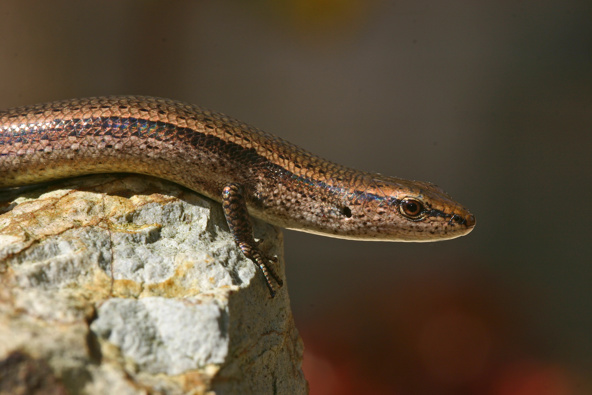In our old Auckland garden we used be surrounded by so-called rainbow skinks.
They were everywhere and… what a cool name!
The best way to describe them: a small grey-brown skink with a dark brown, lateral stripe along the body. When they are sun bathing it is easy to find a spectacular rainbow-coloured sheen on their scales.
I quickly learned these fascinating and quite pretty animals are actually Australian interlopers, arriving here in the 1960s.
Common in the North Island, especially in the northern half: Northland to Waikato with populations in New Plymouth, Hawkes Bay, Whanganui, Palmerston North and Wellington.
There are a few records from Blenheim too.
I was hoping they were not in the South Island – but they are… They can easily live here too – In Tasmania they’re well-established.
Impact: They are numerous and aggressive; accused of eating our native invertebrates and ousting our timid native skink species through competition for space, habitat and food.
Our native skinks are already under pressure from cats and stoats and weasels, so this exotic Aussie skink is likely to add some more pressure.
They are classed as “invasive”, here in New Zealand and if we look at their track record in Hawaii (established there since early 1900s), I would not be surprised if these skinks are having an impact on our herpetological fauna and perhaps other delicate ecological balances.
Isn’t it ironic that this skink’s scientific name is Lampropholis delicata?
Scientists and Biosecurity creatives have re-named that “rainbow skink” to “plague skink”;
Our best approach is to be aware of them and learn to tell them apart from our native skinks
Identifying them from native species is not that easy: you’ve got to look at them up-close and focus on the top of their head; Right in the centre of the head – right on top and between the eyes – is a large diamond-shaped scale. That is the plague/rainbow skink.

If that large scale is divided into two smaller scales, you’re looking at a Native species. Once you know what to look for, you can’t really miss the interloper.
And then there are the creamy white eggs.
You often find these 8 mm eggs in clusters in the soil or underneath rocks. Apart from one rather rare native species of skink (Oligosoma suteri), the Plague Skink is the only one that lays eggs.
If you’re sure you can tell them apart, try catching and dispatching them. Please don’t think they are great “pets” for your kids or grand kids, because they are not! And be aware they are masters at hiding in your luggage when you are travelling. That way they spread themselves all over the place.
Once again, the concept of Biosecurity sneaks back into the garden!
Take your Radio, Podcasts and Music with you










